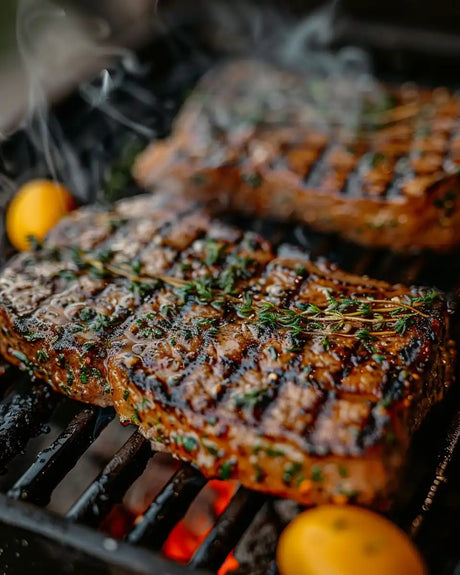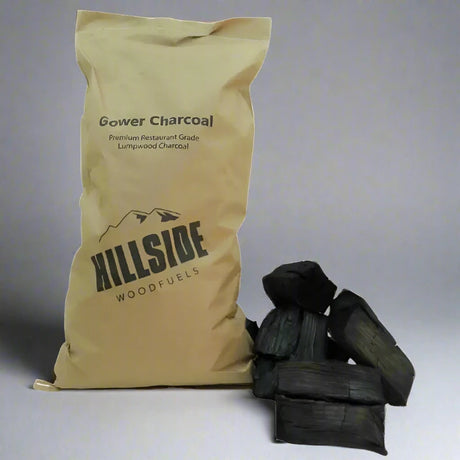Charcoal grilling is a beloved tradition for many, conjuring images of family gatherings and savory aromas. However, this culinary practice also carries an environmental impact that is often misunderstood or overlooked. In 'Evaluating the Environmental Footprint of Charcoal Grilling: Myths and Facts,' we delve into the nuanced relationship between charcoal grilling and the environment, exploring everything from the production process to consumer choices. The article aims to separate fact from fiction, debunk common myths, and offer insights into sustainable practices for those who wish to enjoy grilling with a reduced ecological footprint.
Key Takeaways
- Understanding the complete lifecycle of charcoal grilling is crucial to assessing its environmental impact, from production to disposal.
- Several myths surrounding the carbon emissions and 'cleanliness' of charcoal grilling persist, but evidence-based analysis provides clarity.
- Deforestation, habitat destruction, and air quality concerns are significant environmental costs associated with traditional charcoal grilling.
- Innovations in charcoal production and eco-friendly alternatives are emerging, offering paths toward more sustainable grilling practices.
- Consumers can make informed decisions to reduce their grilling footprint by evaluating environmental claims and adopting eco-conscious grilling tips.
Understanding the Basics of Charcoal Grilling and the Environment
The Process of Charcoal Production
When we consider the environmental footprint of charcoal grilling, it's essential to start at the beginning: the production of charcoal itself. Charcoal is created through pyrolysis, the process of heating wood or other organic materials in the absence of oxygen. This method decomposes the material into charcoal, a carbon-rich residue. The type of wood and the conditions under which pyrolysis occurs can significantly affect the quality and environmental impact of the charcoal produced.
Pyrolysis is not a uniform process, and the efficiency and environmental implications can vary widely. Here's a simplified breakdown of the steps involved:
- Harvesting of wood or collection of organic waste materials.
- Cutting and sizing the material to ensure consistent quality and combustion properties.
- Loading the material into kilns or retorts where controlled pyrolysis takes place.
- Cooling the charcoal and packaging it for transport and sale.
While we often focus on the end-use of charcoal in grilling, the production phase is a critical component of its overall environmental footprint. It's here that the potential for deforestation, emissions, and waste begins.
It's important to note that not all charcoal is created equal. For instance, the premium lump charcoal mentioned for grilling, which is often sought after by home BBQ enthusiasts and culinary professionals, can have a different production process compared to standard briquettes. The choice of charcoal can influence both the flavor of the food and the sustainability of the grilling experience.
Types of Charcoal and Their Environmental Impact
When we consider the environmental impact of charcoal grilling, it's crucial to understand the different types of charcoal available. Lump charcoal, typically made from hardwood, burns hotter and faster. It's often touted as a more natural option, as it contains fewer additives than its counterparts. On the other hand, briquettes are uniform in shape and size, providing a consistent burn rate. However, they often contain binders and fillers that can release harmful chemicals when burned.
Instant-light charcoal, a convenience product, is impregnated with lighter fluid, which can contribute to air pollution and pose health risks. Here's a quick comparison of their environmental impacts:
- Lump charcoal: Higher burn temperature, shorter burn time, fewer additives
- Briquettes: Consistent burn, contains binders and fillers, potential for more chemical release
- Instant-light charcoal: Contains lighter fluid, higher potential for air pollution
While each type of charcoal has its pros and cons, the choice of charcoal can significantly influence the environmental footprint of our grilling practices.
It's important for us to weigh these factors when selecting charcoal for our grills. By choosing wisely, we can reduce our environmental impact and still enjoy the pleasures of grilling.
The Lifecycle of a Charcoal Grill
When we consider the lifecycle of a charcoal grill, it's important to recognize that its environmental impact extends beyond just the grilling sessions. The production, usage, and disposal stages each contribute to the overall footprint. Initially, the materials for the grill are mined and manufactured, which involves energy consumption and emissions.
Durability is a key factor in the lifecycle of a charcoal grill. A well-made, durable grill can last for many years, reducing the need to produce and dispose of grills frequently. Here's a simplified breakdown of the stages:
- Production: Extraction of raw materials, manufacturing, and transportation.
- Usage: Frequency of use, maintenance, and type of charcoal used.
- End of Life: Disposal methods, potential for recycling components.
It's crucial for us to understand that the choices we make at each stage can significantly alter the environmental impact of our grilling habits. Opting for a grill that is built to last and made from sustainable materials, or choosing to recycle parts at the end of its life, can help mitigate negative effects.
Debunking Common Myths About Charcoal Grilling
Myth vs. Reality: Charcoal Grilling's Carbon Emissions
Many of us hold the belief that charcoal grilling is a major contributor to carbon emissions. However, when we delve into the facts, the reality is more nuanced. Charcoal grilling's carbon footprint is often overstated, especially when compared to other cooking methods.
Charcoal is a biomass fuel, and as such, it's part of the natural carbon cycle. The carbon released during grilling is roughly equivalent to the carbon absorbed by the wood during its growth. This closed-loop process can make charcoal grilling more sustainable than it's perceived to be.
The key to reducing the carbon emissions from charcoal grilling lies in sustainable practices and informed choices.
Here's a quick comparison of different grilling methods and their estimated carbon emissions:
| Grilling Method | Estimated CO2 Emissions (per hour) |
|---|---|
| Charcoal Grill | 11 lbs |
| Gas Grill | 5.6 lbs |
| Electric Grill | 15 lbs (depending on the source) |
While charcoal grilling does emit more CO2 than gas grilling, it's important to consider the full lifecycle of the grill and the fuel. Electric grills may seem cleaner, but if the electricity is generated from coal or natural gas, the emissions can be significantly higher.
The Misconception of 'Cleaner' Grilling Alternatives
We often hear about 'cleaner' alternatives to traditional charcoal that promise a reduced environmental impact. However, it's crucial to scrutinize these claims critically. Many alternatives are marketed as '100% natural' or 'sustainable', but the reality is that the production and use of these products can still carry a significant ecological footprint. For instance, some firelighters may be advertised as ethically sourced and environmentally friendly, yet their production may involve processes that are not entirely transparent or sustainable.
It's important to remember that the term 'sustainable' is not regulated and can be used loosely by manufacturers.
When evaluating alternatives, we should consider the full lifecycle of the product, from production to disposal. Here's a quick comparison of common grilling alternatives:
- Traditional Charcoal: High carbon emissions, potential deforestation
- Lump Charcoal: Lower emissions, but sourcing can still lead to deforestation
- Briquettes: May contain additives, longer burning time
- Propane: Lower immediate emissions, but production has a high environmental cost
Ultimately, the choice of grilling material should be informed by a thorough understanding of its environmental impact, rather than marketing slogans.
Sustainable Charcoal: Separating Fact from Fiction
When we talk about sustainable charcoal, it's crucial to understand what sets it apart from conventional options. Sustainable charcoal is produced with environmental considerations at the forefront, often using waste wood or biomass that would otherwise contribute to landfill issues. This type of charcoal aims to reduce the environmental impact associated with traditional charcoal production, such as deforestation and excessive carbon emissions.
One of the premium choices for eco-conscious consumers is restaurant grade charcoal. It's known for providing consistent heat and minimal ash, which not only makes it ideal for grilling and smoking but also means it burns more efficiently. Although it comes with a higher price tag, the benefits include better flavor and potentially fewer environmental drawbacks.
It's important to note that while sustainable charcoal can offer environmental benefits, it's not a silver bullet. The production process still emits carbon dioxide, and the impact on deforestation can vary depending on the source of the wood.
To better understand the choices available, let's look at a comparison:
- Standard Charcoal: Often made from wood, contributing to deforestation; high carbon emissions.
- Restaurant Grade Charcoal: More expensive, burns efficiently, better flavor, and environmental benefits.
- Biomass Charcoal: Made from agricultural waste, lower emissions, reduces waste.
By choosing the right type of charcoal and understanding its production, we can make more informed decisions that align with our environmental values.
The Real Environmental Cost of Charcoal Grilling
Deforestation and Habitat Destruction
When we consider the environmental impact of charcoal grilling, the issue of deforestation and habitat destruction cannot be overlooked. The demand for charcoal contributes significantly to the deforestation of tropical regions, often leading to a loss of biodiversity. The production of charcoal often involves the cutting down of trees, which not only reduces forest cover but also destroys the habitats of countless species.
Deforestation not only affects the local flora and fauna but also has a global impact. Forests are vital carbon sinks, absorbing carbon dioxide from the atmosphere. Their removal accelerates climate change by increasing the amount of greenhouse gases in the atmosphere. Here's a brief overview of the impact:
- Loss of tree cover reduces the Earth's capacity to absorb carbon dioxide.
- Destruction of habitats leads to a decline in biodiversity.
- Soil erosion and water cycle disruption occur as a result of tree removal.
We must acknowledge the chain reaction that begins with the simple act of lighting up a charcoal grill. The consequences extend far beyond our backyards, affecting ecosystems and the global climate.
It's crucial for us to explore sustainable alternatives and practices that can mitigate these environmental concerns. By doing so, we can enjoy the benefits of grilling without compromising the health of our planet.
Air Quality and Health Implications
When we consider the impact of charcoal grilling on air quality, we must acknowledge the release of pollutants such as volatile organic compounds (VOCs), carbon monoxide, and particulate matter. These emissions can contribute to smog formation and pose health risks, particularly for those with respiratory conditions.
The use of sustainable charcoal can mitigate some of these effects. For instance, kiln dried logs and lumpwood charcoal are known for their quick and consistent heat, and they are often marketed as a more eco-friendly choice. However, it's important to scrutinize these claims to ensure they are not merely a sales pitch for premium charcoal options.
- VOCs and particulate matter affect local air quality
- Carbon monoxide poses a risk to human health
- Sustainable charcoal options may reduce emissions
While we strive for an exceptional grilling experience, we must also consider the environmental and health implications of our choices. Exclusive deals for subscribers should not overshadow the importance of selecting eco-friendly products.
In summary, the pursuit of a better grilling experience should not come at the cost of our health or the environment. By choosing responsibly sourced charcoal and being aware of the emissions associated with grilling, we can enjoy our barbecues with a clearer conscience.
Carbon Footprint of Charcoal Grilling
When we consider the carbon footprint of charcoal grilling, it's essential to recognize the full scope of its environmental impact. The emissions from charcoal grilling go beyond just the CO2 released during cooking; they start with the deforestation required to produce the charcoal and end with the disposal of ash.
Charcoal production, especially from non-renewable wood sources, contributes significantly to greenhouse gas emissions. However, choosing premium hardwood charcoal can mitigate some of these effects. This selection, often touted for an elevated grilling experience, also promises eco-friendly sourcing and higher heat output.
The choice of charcoal is pivotal in determining the overall environmental impact of our grilling habits.
Here's a quick look at the carbon footprint of different charcoal types:
| Charcoal Type | CO2 Emissions (kg per grilling session) |
|---|---|
| Lump Hardwood | 15.5 |
| Briquettes | 22.0 |
| Coconut Shell | 10.0 |
By being mindful of the charcoal we use and opting for sustainable options, we can significantly reduce our grilling footprint.
Innovations and Sustainable Practices in Charcoal Grilling
Eco-friendly Charcoal Alternatives
As we explore the realm of sustainable grilling, we've come across a variety of eco-friendly charcoal alternatives that promise a lower environmental impact. Biomass briquettes and coconut shell charcoal are just a couple of examples that burn cleaner and are produced from renewable resources.
Biodegradable waste, such as sawdust and agricultural residues, is often used to create these alternatives, reducing the reliance on traditional wood charcoal. This not only helps in managing waste but also in cutting down the deforestation rates associated with charcoal production.
Here's a quick comparison of traditional charcoal and some eco-friendly alternatives:
- Traditional Charcoal: High carbon emissions, contributes to deforestation
- Biomass Briquettes: Lower emissions, made from organic waste
- Coconut Shell Charcoal: Sustainable, burns at a higher temperature
By choosing eco-friendly alternatives, we are not only mitigating our carbon footprint but also encouraging the growth of sustainable practices within the industry.
Advancements in Charcoal Production Techniques
In our quest for more sustainable grilling practices, we've witnessed significant advancements in charcoal production techniques. These innovations aim to reduce the environmental impact while maintaining the quality and performance that grill enthusiasts love. One such development is the use of biomass as a raw material, which includes agricultural waste and sustainably sourced wood. This not only minimizes deforestation but also utilizes materials that would otherwise contribute to waste.
The shift towards more eco-friendly production methods is not just beneficial for the environment; it also supports local economies by creating green jobs.
Another key improvement is the introduction of more efficient kilns that lower emissions and increase yield. Here's a brief overview of the changes:
- Traditional earth-mound kilns are being replaced by modern retort kilns.
- Retort kilns capture and reuse gases, leading to a cleaner burn.
- Improved kiln insulation reduces the amount of fuel needed.
By embracing these techniques, we can enjoy our grilling traditions with a clearer conscience, knowing that we are contributing to a healthier planet.
Consumer Choices and Their Impact on Sustainability
As we explore the realm of charcoal grilling, we must acknowledge that our individual choices play a pivotal role in the environmental narrative. The products we purchase and the practices we adopt can collectively drive significant change towards sustainability.
When selecting grilling products, opting for eco-friendly charcoal, such as those made from coconut shells or bamboo, can reduce deforestation and lower emissions. It's not just about the type of charcoal, but also how we use it. Efficient grilling techniques, like minimizing the lid opening and using the right amount of charcoal, can reduce waste and pollution.
- Choose sustainably sourced charcoal
- Employ efficient grilling practices
- Invest in a durable grill to avoid frequent replacements
By making informed decisions, we not only enhance our grilling experience but also contribute to a healthier environment. Our collective actions can lead to a reduction in the negative impacts associated with charcoal grilling.
Making Informed Decisions for Eco-conscious Grilling
Evaluating the Environmental Claims of Grill Manufacturers
As we navigate the market for grills, we often encounter bold environmental claims made by manufacturers. It's crucial to approach these with a critical eye. Not all 'eco-friendly' labels translate to a genuinely lower environmental impact. Manufacturers may tout their products as 'green' based on a narrow set of criteria, ignoring broader ecological implications.
To assess the veracity of these claims, we must consider multiple factors:
- The materials used in the grill's construction
- The efficiency of the grill's design in terms of fuel consumption
- The sustainability of the fuel recommended by the manufacturer
- The longevity and recyclability of the grill
It's essential to look beyond the marketing and examine the full lifecycle of the product. This includes the sourcing of materials, production processes, and the end-of-life disposal options.
When evaluating grills, one should not only rely on the claims of manufacturers but also seek out independent certifications and customer reviews. These can provide a more balanced view of the product's environmental footprint. Remember, the most sustainable grilling option is one that aligns with both your needs and the well-being of our planet.
Tips for Reducing Your Grilling Footprint
As we gather around the grill, it's important to remember that our choices have a direct impact on the environment. Choosing the right type of charcoal is a simple yet effective step towards sustainable grilling. Opt for sustainably harvested, domestically sourced lumpwood charcoal, which not only burns better but also produces minimal ash and enhances the flavor of your food.
By following usage tips for optimal grilling, we can ensure that our outdoor cooking sessions are as eco-friendly as they are enjoyable.
To further minimize our environmental impact, consider these additional practices:
- Use a chimney starter instead of lighter fluid to avoid releasing harmful chemicals into the air.
- Keep the grill lid closed as much as possible to retain heat and reduce the amount of charcoal needed.
- After grilling, properly extinguish and dispose of charcoal ash to prevent unnecessary waste and pollution.
Together, we can make a difference with every cookout by being mindful of our grilling habits and the products we choose.
The Future of Grilling: Trends and Predictions
As we look towards the horizon of outdoor cooking, we see a landscape that is rapidly evolving. Innovations in grilling technology and a growing awareness of environmental issues are shaping the future of how we grill. We're witnessing a shift towards more sustainable practices, and it's exciting to imagine the possibilities.
- The rise of electric grills, powered by renewable energy, could significantly reduce the carbon footprint associated with traditional grilling.
- Plant-based charcoal alternatives are gaining traction, offering a way to enjoy the smoky flavors without the environmental guilt.
- Smart grills with energy-efficient designs and precision cooking controls are set to become more prevalent, reducing waste and improving the overall grilling experience.
The key to a greener grilling future lies in our collective efforts to embrace these changes and make conscious choices. It's not just about the grill we use, but also how we use it.
As consumers, we have the power to drive demand for eco-friendly grilling options. By supporting companies that prioritize sustainability and by being mindful of our own grilling habits, we can all contribute to a healthier planet. The grills of tomorrow promise to bring us the joy of cooking outdoors in ways that align with our environmental values.
Conclusion
In summary, the environmental footprint of charcoal grilling is a nuanced topic that requires a careful examination of both myths and facts. While charcoal grilling does emit pollutants and contribute to deforestation, sustainable practices and informed choices can mitigate some of these impacts. It is crucial for consumers to recognize the importance of sourcing sustainably produced charcoal and employing efficient grilling techniques. Moreover, understanding the lifecycle of charcoal and the role of alternative grilling options can empower individuals to make environmentally conscious decisions. Ultimately, the key to reducing the ecological impact lies in education, innovation, and a commitment to sustainability in our outdoor cooking habits.
Frequently Asked Questions
Is charcoal grilling worse for the environment than gas grilling?
Charcoal grilling typically has a higher carbon footprint than gas grilling due to the production process and the release of more carbon dioxide and particulates during combustion. However, the overall environmental impact also depends on the source of the gas and charcoal.
Can charcoal be produced in an environmentally friendly way?
Yes, sustainable methods of producing charcoal exist, such as using renewable feedstocks and more efficient production technologies that reduce emissions and waste.
Does charcoal grilling contribute to deforestation?
Traditional charcoal production can contribute to deforestation if it relies on wood from non-sustainable sources. However, eco-friendly charcoal can be made from waste materials or sustainably managed forests.
What are some eco-friendly alternatives to traditional charcoal?
Eco-friendly alternatives include briquettes made from agricultural waste, coconut shells, or sustainably sourced wood, as well as lump charcoal from responsibly managed forests.
How can I reduce my environmental impact when grilling with charcoal?
To reduce your impact, use sustainably produced charcoal, avoid lighter fluid, fully extinguish coals to prevent air pollution, and maintain your grill to extend its lifespan.
Are electric grills a better environmental choice than charcoal grills?
Electric grills have a lower direct environmental impact since they don't produce combustion emissions. However, the environmental friendliness of electric grills also depends on the source of the electricity, with renewable sources being the most sustainable option.








